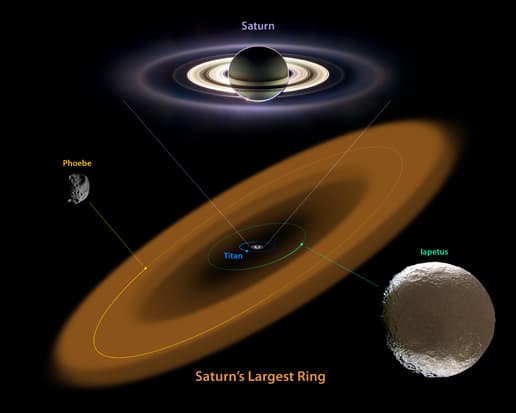Why does Iapetus have two colours?
Chris, South Africa

Iapetus is the third largest satellite of Saturn, and it is the largest object in the solar system not in hydrostatic equilibrium. Iapetus is known for its colour dichotomy. It has a dark side and white side, and it is often called the Yin Yang moon. This fact was known since its discovery in 1671 by the Italian Astronomer Giovanni Cassini. During his first few observations, Cassini was able to see it only on one side of Saturn, and when he eventually observed it on both sides, he discovered that one side was much dimmer than the other.
Although the peculiar coloration of Iapetus has been known for centuries, the mystery has only been solved very recently, just in 2009. There is no technical or complex explanation for what happens to Iapetus. The closest description for it is: bugs on a windshield.
Iapetus is tidally locked to Saturn. Like our own Moon, showing always the same face. Iapetus has a side always facing forward in the direction of motion and side facing away. So, one side is constantly exposed to infalling material just like bugs on the windshield of a fast car.
But where does this material come from?
The culprit is another satellite of Saturn named Phoebe. Phoebe is bombarded my micrometeorites, releasing dust particles from the moon, and which over the ages accumulate around Saturn forming a new ring. In 2009, the Infrared satellite Spitzer observed this bigger and tenuous ring, not visible to the naked eye. The Phoebe ring is over 1 million kilometres thick (about 20 times Saturn’s diameter), and it extend between 6 million and 12 million kilometres from Saturn.

Iapetus orbits in prograde motion around Saturn (in agreement with Saturn’s own rotation on itself) with an inclination of 15.47° with respect to Saturn’s equator. Meanwhile, Pheobe revolves around Saturn with a retrograde motion and so does its ring. So on its tranquil revolution around Saturn, Iapetus is flying through a fine cloud of dust. Since Iapetus is always facing in the same direction, the fine dust has accumulated, covering one side of the moon and not the other.
